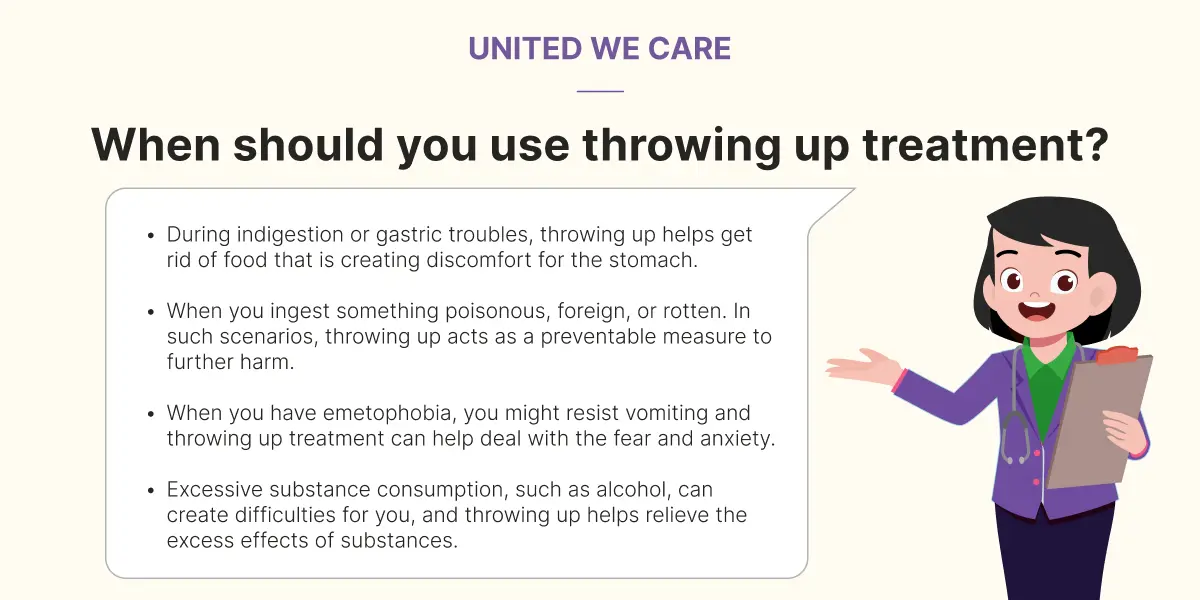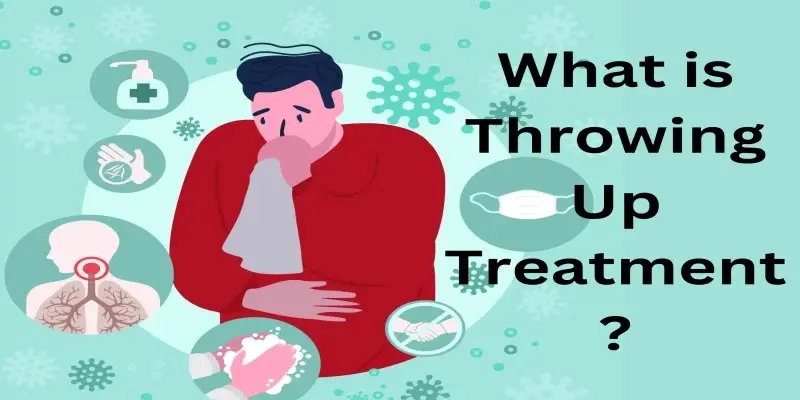Introduction
Usually, vomiting or throwing up is seen as a symptom of illness. However, there can be several issues that might cause you to throw up on purpose. There are numerous benefits to throwing up treatment, as it can help clear the stomach.
Throwing up treatment refers to the process of inducing vomiting or throwing up on purpose as a form of treatment. In ancient times, it was followed regularly as medications were not easily available. Although it is not practiced widely in modern times, it can be essential in times of need.
Let’s find out more about this form of treatment below.
What is Throwing Up?
In essence, throwing up refers to the process of removing the contents of the stomach through the mouth. While throwing up is similar to vomiting, there are key differences. Throwing up is voluntary, whereas vomiting is involuntary. Vomiting is the self-mechanism of the body triggered due to some illness. Throwing up, on the contrary, is induced on purpose in scenarios where the body is triggering it on its own.
By the same token, it is important to understand when your body or you have to throw up or vomit. Firstly, vomit is induced by the body when there are foreign particles in the stomach. These foreign particles irritate the stomach, and therefore, the stomach tries to release the ingredients immediately.
Secondly, an illness where vomiting is a symptom is induced by the body. Likewise, throwing up voluntarily comes from a need to release the content of the stomach quickly, where other mediums of cure are unavailable.
What is Throwing Up Treatment?
Namely, throwing up treatment comes from a need to vomit where emptying the stomach content is essential. Moreover, relieving the stomach content on your own through vomiting can be dangerous and should be initiated only in cases of emergencies. Read more about this below:
When should you use throwing up treatment?
Indeed, most medical advice revolves around taking medications for discomfort in the stomach or any other ailment. Unfortunately, in some situations, removing the contents of the stomach becomes imminent. Also, medical support is not always available immediately. In such situations, throwing up acts as a way to relieve the concerns without significant harm.
Similarly, below are scenarios or conditions in which throwing up can be useful:

- During indigestion or gastric troubles, throwing up helps get rid of food that is creating discomfort for the stomach.
- When you ingest something poisonous, foreign, or rotten. In such scenarios, throwing up acts as a preventable measure to further harm.
- When you have emetophobia, you might resist vomiting and throwing up treatment can help deal with the fear and anxiety.
- Excessive substance consumption, such as alcohol, can create difficulties for you, and throwing up helps relieve the excess effects of substances.
How to Throw Up?
Indeed, throwing up is an emergency-based treatment. You should not practice this form of treatment without proper consultation from a doctor. Moreover, throwing up should be practiced carefully with proper precautions such as keeping yourself hydrated, resting adequately, and maintaining proper hygiene.
As mentioned above, for throwing up treatment, below are some of the common ways in which you can induce vomiting for the treatment.
- Use your gag reflex by inserting a finger gently towards the back of your mouth or gargling with warm water.
- Drinking warm water with salt can also lead to vomiting.
Why Throwing Up Treatment is Important?
Practically, there are medications available for the most common ailments in the world. But, during emergencies, it can be difficult to get appropriate medical help. Moreover, medical intervention is avoided by simpler means. Throwing up is a self-conducted form of treatment. Here is the list of circumstances in which throwing up treatment can be helpful.
Emergencies
Primarily, when you ingest something poisonous, perhaps an item you’re allergic to or something rotten, throwing it up before your stomach absorbs it can be life-saving. Throwing up saves your stomach from coming in touch with the contents of your stomach and reduces the effect a poisonous item might have on your body. Similarly, foreign objects such as glass, coal, etc can create injuries in your stomach lining, and vomiting can save you from the danger.
Phobias
Essentially rare, but a useful effect of this treatment is for individuals who suffer from a specific form of phobia, namely emetophobia. Those with emetophobia have difficulty in seeing, thinking, or having vomit and develop extreme fear or anxiety of the same. The treatment can help them normalize vomit and reduce the fear associated with it.
Gastric issues
Practically, a major amount of indigestion or other gastric issues stem from eating food items that don’t sit well with the stomach. In such scenarios, vomiting the food that is creating issues in the stomach can help get relief from stomach ailments. Moreover, it can also help cleanse the stomach of otherwise difficult-to-digest food particles.
Substance
Finally, consumption of alcohol is quite common, and drinking in excessive quantities can lead to dizziness, stomach burns, and intoxication-related issues. Similarly, ingesting other substances, such as chewing tobacco, can also create gastric issues. Throwing up can be a useful way to sober yourself in emergencies where you’ve had too much to drink.
Conclusion
In conclusion, we read about what vomiting voluntarily entails as compared to involuntarily by the body. Furthermore, throwing up is a treatment that has significant benefits in emergencies and scenarios where poisonous items are involved. It is important that throwing up treatment is practiced with caution and under consultation by a doctor. Furthermore, drinking warm water with salt and gargling with warm water are some of the common ways to induce throwing up. To get in touch with the right healthcare professionals, reach out to United We Care.
References
[1] K. J. Forney, J. M. Buchman-Schmitt, P. K. Keel, and G. K. W. Frank, “The medical complications associated with purging,” International Journal of Eating Disorders, vol. 49, no. 3, pp. 249–259, Feb. 2016, doi: https://doi.org/10.1002/eat.22504.[2] S. Sivakumar and A. Prabhu, “Physiology, Gag Reflex,” PubMed, 2022. https://pubmed.ncbi.nlm.nih.gov/32119389/









